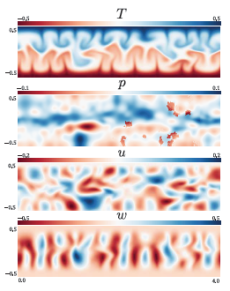Deep-Learning Research Nominated for Best Student Paper Award at SC20
November 16, 2020

An illustration of a typical solution to the Rayleigh–Benard problem. The contours respectively show the solution for temperature (T), pressure (p), and the two velocity components (u and w).
A paper describing MeshfreeFlowNet — an open-source, physics-constrained, deep-learning approach for simultaneously enhancing the spatial and temporal resolution of scientific data — is a finalist for the Best Student Paper Award at SC20.
“MeshfreeFlowNet is a big step forward in terms of physics-constrained machine learning algorithm development, combining important criteria necessary for scientific data: physics-based partial differential equation constraints, a mesh-free design that allows arbitrary resolution, scalability, and the ability to ingest data priors,” said Max Jiang, lead author on the paper and a Ph.D. student at UC Berkeley who has been affiliated with the Data Analytics Group at Berkeley Lab’s National Energy Research Scientific Computing Center (NERSC) since 2018.
High-fidelity, high-resolution data is critical for improving our understanding of scientific phenomena and for a range of decision- and policy-making — for example, in the context of climate change. High-resolution simulations of complex systems are prohibitively expensive, and high-resolution observations and experiments often do not contain reliable information at the fine scales. To address these issues, MeshfreeFlowNet generates spatio-temporal solutions at arbitrarily high resolution from low-resolution inputs, while being computationally efficient and accurately recovering the fine-scale quantities of interest.
In early demonstrations on the GPU processors on NERSC’s Cori supercomputer, Jiang and his colleagues demonstrated that MeshfreeFlowNet can scale to up to 128 GPUs with 96.8% scaling efficiency with a training time of less than 4 minutes.
Jiang will present the research findings Tues., Nov. 17, at SC20, 11-11:30 am EST, 8-8:30 am PST.
About NERSC and Berkeley Lab
The National Energy Research Scientific Computing Center (NERSC) is a U.S. Department of Energy Office of Science User Facility that serves as the primary high performance computing center for scientific research sponsored by the Office of Science. Located at Lawrence Berkeley National Laboratory, NERSC serves almost 10,000 scientists at national laboratories and universities researching a wide range of problems in climate, fusion energy, materials science, physics, chemistry, computational biology, and other disciplines. Berkeley Lab is a DOE national laboratory located in Berkeley, California. It conducts unclassified scientific research and is managed by the University of California for the U.S. Department of Energy. »Learn more about computing sciences at Berkeley Lab.







